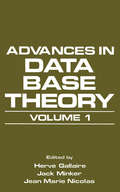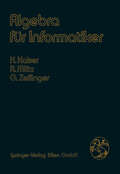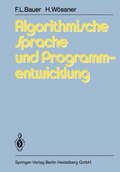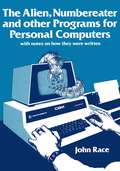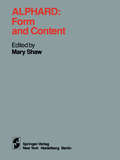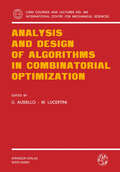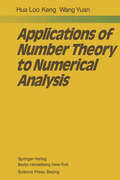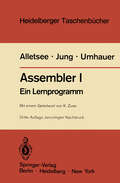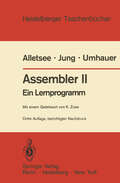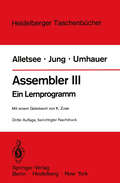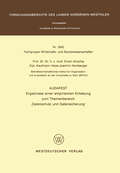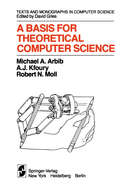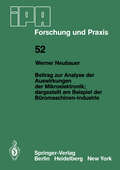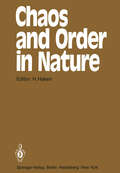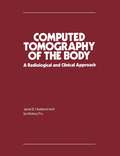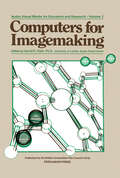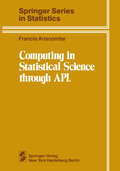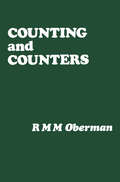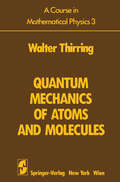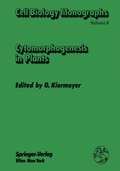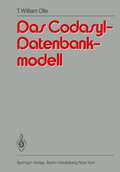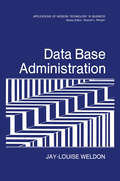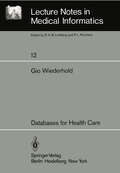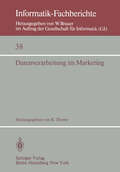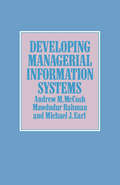- Table View
- List View
Algebra für Informatiker
by Hans Kaiser Rainer Mlitz Gisela ZeilingerDas Kernstück des vorliegenden Buches entstand aus einer einsemestrigen Vor lesung gleichen Namens, die die Autoren seit mehreren Studienjahren an der Technischen Universität Wien betreuen und die von R.Mlitz ausgearbeitet wurde. Es erschien den Autoren notwendig bzw. zweckmäßig dieses Kernstück zu ergänzen durch lineare Algebra - die an der TU Wien getrennt vorgetragen wird - und graphentheoretische Grundbegriffe. Die von den Autoren gewonnenen Erfahrungen haben die vom üblichen Schema abweichenden didaktischen Aspekte der Darstellung geprägt, deren Grundprinzip in der nachfolgenden Einleitung erläutert wird. Das Buch richtet sich zunächst an Studierende der Informatik zum Gebrauch neben entsprechenden Vorlesungen, zum Nachschlagen und Wiederholen. Darüber hinaus soll der Anwender angesprochen werden, der in dem Werk die wichtigsten algebraischen Methoden des Informatikers dargeboten findet. Die Darstellung beschränkt sich auf den mathematischen Hintergrund und dessen direkte Anwendung. Bezüglich eventueller technischer Realis;erungen sei auf die entsprechende Literatur verwiesen. Unser besonderer Dank gilt Frau E.Wiesenbauer und Frau H.Reinauer für die sorgfältig durchgeführten Schreibarbeiten, Herrn Mag.W.Nowak für die genaue Ausführung der Graphiken, sowie dem Springer-Verlag Wien für sein Entgegenkommen und die gute Zusammenarbeit.
Alphard: Form and Content
by Mary ShawAlphard is a design for a programming system that supports the abstraction and verification techniques required by modern program'ming methodology. During the language design process, we were concerned simultaneously with problems of methodology, correctness, and efficiency. Methodological concerns are addressed through facilities for defining new, task·specific abstractions that capture complex notions in terms of their intended properties, without explicating them in terms of specific low· level implementations. Techniques for verifying certain properties of these programs address the correctness concerns. Finally, the language has been designed to permit compilation to efficient object code. Although a compiler was not implemented, the research shed light on specification issues and on programming methodology. an abstraction, specifying its behavior Alphard language constructs allow a programmer to isolate publicly while localizing knowledge about its implementation. The verification of such an abstraction consists of showing that its implementation behaves in accordance with the public specification. Given such a verification, the abstraction may be used with confidence to construct higher·level, more abstract, programs. The most common kind of abstraction in Alphard corresponds to what is now called an abstract data type. An abstract data type comprises a set of values for elements of the type and a set of operations on those values. A new language construct, the form, provides a way to encapsulate the definitions of data structures and operations in such a way that only public information could be accessed by the rest of the program.
Analysis and Design of Algorithms in Combinatorial Optimization (CISM International Centre for Mechanical Sciences #266)
by Giorgio Ausiello M. LucertiniApplications of Number Theory to Numerical Analysis
by L.-K. Hua Y. WangOwing to the developments and applications of computer science, ma thematicians began to take a serious interest in the applications of number theory to numerical analysis about twenty years ago. The progress achieved has been both important practically as well as satisfactory from the theoretical view point. It'or example, from the seventeenth century till now, a great deal of effort was made in developing methods for approximating single integrals and there were only a few works on multiple quadrature until the 1950's. But in the past twenty years, a number of new methods have been devised of which the number theoretic method is an effective one. The number theoretic method may be described as follows. We use num ber theory to construct a sequence of uniformly distributed sets in the s dimensional unit cube G , where s ~ 2. Then we use the sequence to s reduce a difficult analytic problem to an arithmetic problem which may be calculated by computer. For example, we may use the arithmetic mean of the values of integrand in a given uniformly distributed set of G to ap s proximate the definite integral over G such that the principal order of the s error term is shown to be of the best possible kind, if the integrand satis fies certain conditions.
Assembler I: Ein Lernprogramm (Heidelberger Taschenbücher #140)
by Rainer Alletsee Horst Jung Gerd F. UmhauerAls die Computer nach ihren ersten Pionierjahren etwa zwischen 1950 und 1960 in die Praxis Eingang fanden, lieB sich kaum voraussehen, welche Bedeutung einmal der organisatorische Teil einschlieBlich der Programmierung erlangen wiirde. Heute wissen wir, daB beim Compu tereinsatz die sogenannte »Software« mindestens so wichtig ist, wie die eigentliche »Hardware«. Auch ·dabei haben wir ein weites Feld, welches von strengen Theorien bis zu praxisbezogenen Arbeiten reicht. Das vorliegende Buch dient nun voll und ganz dem praktischen Einsatz der Computer. Es gibt ein gutes Bild davon, welche ungeheure Kleinar beit zu leisten ist, urn die moderne elektronische Datenverarbeitung in Gang zu setzen und in Betrieb zu halten. Das zwingt zu einer neuen Gei steshaltung und zu einer strengen Disziplin in der Verwendung von Ideen und Mitteln. Jedes Zeichen, jede Aktion, jede Anweisung muB gut durchdacht sein, und es ist kein Platz rur Schwarmerei mit unausgegore nen Ideen. So konnte sich die Datenverarbeitung auch iiber ihr eigenes Arbeitsge biet hinaus positiv auswirken und in einer in vieler Hinsicht verworrenen Zeit formend und bildend rur die ganze Gesellschaft wirken, indem ihr Geist iiber eigentliche Fachkreise hinaus wirksam wird. Hiinfeld, im August 1973 Konrad Zuse v Vorwort zur dritten Auflage In der voriiegenden, v611ig neubearbeiteten 3. Auflage dieses dreiteiligen Lernprogramms werden die heute gangigen Regeln fUr eine wohlstruktu rierte Assemblerprogrammierung erlautert und angewendet. AuBerdem wurden die bekanntgewordenen Fehler korrigiert. An dieser Stelle m6chten wir auch auf den inzwischen herausgegebenen Supplementband (Teil IV) hinweisen.
Assembler II: Ein Lernprogramm (Heidelberger Taschenbücher #141)
by Rainer Alletsee Horst Jung Gerd F. UmhauerAssembler III: Ein Lernprogramm (Heidelberger Taschenbücher #142)
by Rainer Alletsee Horst Jung Gerd F. UmhauerAudafest: Ergebnisse einer empirischen Erhebung zum Themenbereich “Datenschutz und Datensicherung” (Forschungsberichte des Landes Nordrhein-Westfalen #3042)
by Erwin GrochlaA Basis for Theoretical Computer Science (Monographs in Computer Science)
by M.A. Arbib A.J. Kfoury R.N. MollComputer science seeks to provide a scientific basis for the study of inform a tion processing, the solution of problems by algorithms, and the design and programming of computers. The last forty years have seen increasing sophistication in the science, in the microelectronics which has made machines of staggering complexity economically feasible, in the advances in programming methodology which allow immense programs to be designed with increasing speed and reduced error, and in the development of mathematical techniques to allow the rigorous specification of program, process, and machine. The present volume is one of a series, The AKM Series in Theoretical Computer Science, designed to make key mathe matical developments in computer science readily accessible to under graduate and beginning graduate students. Specifically, this volume takes readers with little or no mathematical background beyond high school algebra, and gives them a taste of a number of topics in theoretical computer science while laying the mathematical foundation for the later, more detailed, study of such topics as formal language theory, computability theory, programming language semantics, and the study of program verification and correctness. Chapter 1 introduces the basic concepts of set theory, with special emphasis on functions and relations, using a simple algorithm to provide motivation. Chapter 2 presents the notion of inductive proof and gives the reader a good grasp on one of the most important notions of computer science: the recursive definition of functions and data structures.
Beitrag zur Analyse der Auswirkungen der Mikroelektronik;Dargestellt am Beispiel der Büromaschinen-Industrie: Dargestellt am Beispiel der Büromaschinen-Industrie (IPA-IAO - Forschung und Praxis #52)
by W. NeubauerChaos and Order in Nature: Proceedings of the International Symposium on Synergetics at Schloß Elmau, Bavaria April 27 – May 2, 1981 (Springer Series in Synergetics #11)
by Hermann HakenThis book contains the invited papers of an international symposium on synergetics; which was held at Schlol3 Elmau, Bavaria, FRG, April 27 to May 1, 1981. At our previous meetings on synergetics the self-organized formation of structures in quite different disciplines stood in the foreground of our interest. More recently it has turned out that phenomena characterized by the word "chaos" appear in various disciplines, and again far-reaching analogies in the behavior of quite different systems become visible. Therefore this meeting was devoted not only to problems connected with the occurrence of ordered structures but also to most recent results obtained in the study of chaotic motion. In the strict mathematical sense we are dealing here with deterministic chaos, i. e. , irregular motion described by deter ministic equations. While in this relatively young fieJd of research computer ex periments and computer simulations predominated in the past, there now seems to be a change of trend, namely to study certain regular features of chaos by analytical metbods. I think considerable progress has been achieved in this respect quite recently. This theoretical work is paralleled by a number of very beautiful experi ments in different fields, e. g. , fluid dynamics, solid-state physics, and chemistry. For the first time at this kind of meeting we have included plasma physics, which presents a number of most fascinating problems with respect to instabilities, formation of structures, and related phenomena.
Computed Tomography of the Body: A Radiological and Clinical Approach (pdf)
by Janet E. Husband Ian Kelsey FryComputers for Imagemaking
by D. ClarkComputers for Image-Making tells the computer non-expert all he needs to know about Computer Animation. In the hands of expert computer engineers, computer picture-drawing systems have, since the earliest days of computing, produced interesting and useful images. As a result of major technological developments since then, it no longer requires the expert's skill to draw pictures; anyone can do it, provided they know how to use the appropriate machinery. This collection of specially commissioned articles reflects the diversity of user applications in this expanding field
Computing in Statistical Science through APL (Springer Series in Statistics)
by Francis John AnscombeA t the terminal seated, the answering tone: pond and temple bell. ODAY as in the past, statistical method is profoundly affected by T resources for numerical calculation and visual display. The main line of development of statistical methodology during the first half of this century was conditioned by, and attuned to, the mechanical desk calculator. Now statisticians may use electronic computers of various kinds in various modes, and the character of statistical science has changed accordingly. Some, but not all, modes of modern computation have a flexibility and immediacy reminiscent of the desk calculator. They preserve the virtues of the desk calculator, while immensely exceeding its scope. Prominent among these is the computer language and conversational computing system known by the initials APL. This book is addressed to statisticians. Its first aim is to interest them in using APL in their work-for statistical analysis of data, for numerical support of theoretical studies, for simulation of random processes. In Part A the language is described and illustrated with short examples of statistical calculations. Part B, presenting some more extended examples of statistical analysis of data, has also the further aim of suggesting the interplay of computing and theory that must surely henceforth be typical of the develop ment of statistical science.
A Course in Mathematical Physics 3: Quantum Mechanics of Atoms and Molecules
by Walter ThirringIn this third volume of A Course in Mathematical Physics I have attempted not simply to introduce axioms and derive quantum mechanics from them, but also to progress to relevant applications. Reading the axiomatic litera ture often gives one the impression that it largely consists of making refined axioms, thereby freeing physics from any trace of down-to-earth residue and cutting it off from simpler ways of thinking. The goal pursued here, however, is to come up with concrete results that can be compared with experimental facts. Everything else should be regarded only as a side issue, and has been chosen for pragmatic reasons. It is precisely with this in mind that I feel it appropriate to draw upon the most modern mathematical methods. Only by their means can the logical fabric of quantum theory be woven with a smooth structure; in their absence, rough spots would . inevitably appear, especially in the theory of unbounded operators, where the details are too intricate to be comprehended easily. Great care has been taken to build up this mathematical weaponry as completely as possible, as it is also the basic arsenal of the next volume. This means that many proofs have been tucked away in the exercises. My greatest concern was to replace the ordinary cal culations of uncertain accuracy with better ones having error bounds, in order to raise the crude manners of theoretical physics to the more cultivated level of experimental physics.
Cytomorphogenesis in Plants (Cell Biology Monographs #8)
by Oswald KiermayerIn 1958 E. BUNNING published a book in the former series "Proto plasmatologia" entitled "Polaritat und inaquale Teilung des pflanzlichen Protoplasten" (polarity and unequal division of the plant protoplast) in which for the first time results of experimental plant cytomorphogenesis were re viewed. This book was based completely on light microscopic observations and rather simple experimental techniques. Since then our knowledge of basic cytomorphogenetic mechanisms has greatly increased, especially with the introduction of modern ultrastructural, biochemical and sophisticated experi mental methods so that the field of cytomorphogenesis in our days should be considered a separate discipline within the general field of cell biology. This book, "Cytomorphogenesis in Plants", represents a necessary attempt to bring together current knowledge in this field of research on a comparable basis. Unfortunately enormous gaps in our understanding of the underlying principles of cytomorphogenetic events still exist. Therefore it seemed reason able to present a book composed of individual chapters, each written by experts for a defined experimental system. Each chapter represent a separate treatise with its own references, hence it was not possible to avoid some overlap both in the text and in the literature of the chapters without destroying the uni formity of the respective article.
Data Base Administration (Applications of Modern Technology in Business)
by Jay-Louise WeldonIn modem organizations, data has been added to the classical economic assets of land, labor, and capital. Data on company products, finances, and operations are gathered into data bases that are used to support management reporting and decision making. Effective use of these data bases requires control over their design and development and coordination among the various users. The exercise of these management functions is called data base administration (DBA). DBA is an evolutionary area. In many organizations, it was formed as a response to the problems created by the installation of sophisticated systems for data base management. As a result, the practice of DBA has been strongly influ enced by its technological and organizational environment. The size, organiza tional position, staffing, and defined role of DBA vary from firm to firm. How ever, certain fundamental tasks and responsibilities are, or should be, recognized as the province of DBA. To date, literature on the DBA function is sparse. Most texts on data base management systems (Date, 1975; Kroenke, 1977; Martin, 1978; Sprowls, 1976; Tsichritzis and Lochovsky, 1977)* discuss DBA as one aspect of that technology.
